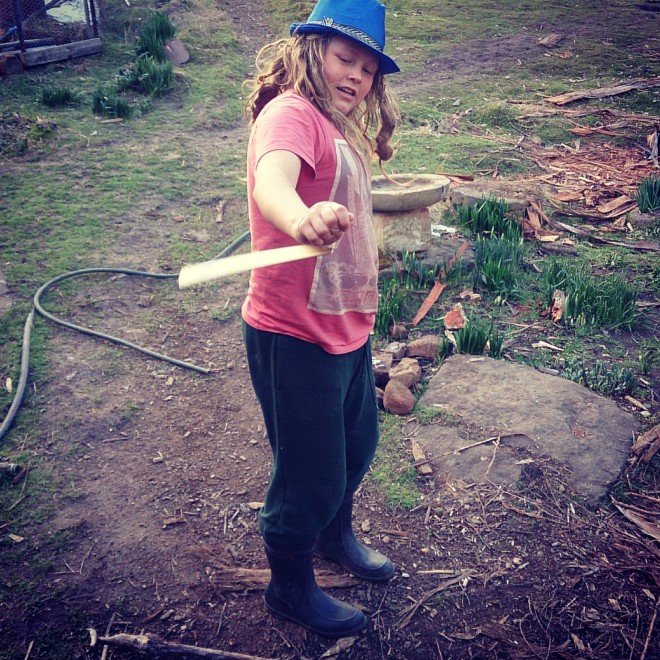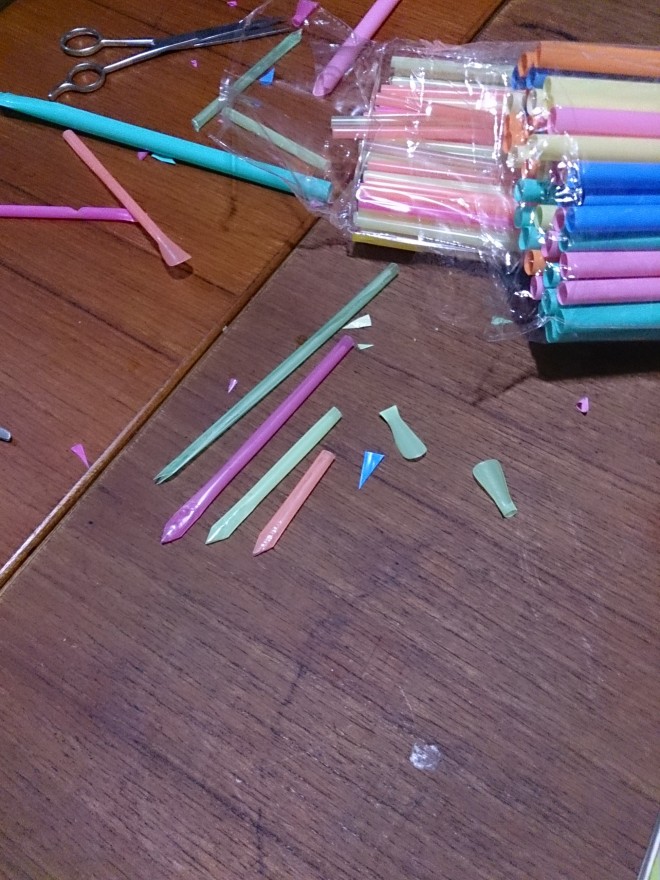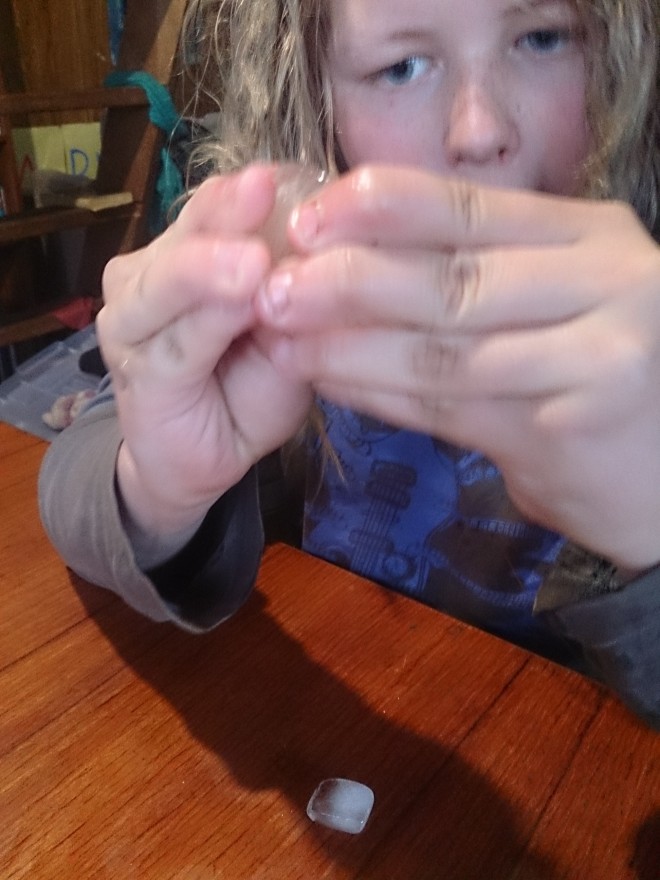Did we really do physics recently? It sure seems like ages ago! I’ve been meaning to jot this down for a while but as you’ll see at the end of this post I got a bit distracted by getting pregnant 🙂
So, I started a grade 6 physics block with Elki earlier in the year. It’s not really thorough and we stopped mid working through ‘Heat’ but we had a lot of fun sharing some hands on activities and experiments. I decided I would not require any writing at all from Elki for this block. I really thought he would gain the most from it just by experiencing the phenomena, and that recording everything that we did would end up being very tedious for him and not enhance his understanding or knowledge of the subject.
We began with a couple of activities for Colour and Light. I read this article by Hans Gebert and chose a couple of the activites that we were able to do at home. Firstly though we each painted a colour circle (this is a lesson from Painting and Drawing in Waldorf Schools).
Elki’s circle
My circle
After this we created the Physiological Complimentary colour pairs using paint on white paper, and explored the phenomenon of coloured shadows using a red coloured torch light and a normal torch light. I used paint brushes as the objects and our screen was just a large piece of white paper. Both of these activities were really effective, but with the first Elki definitely found it easiest to see the green after-image for red than either of the other colours.
We then painted another colour circle with the complimentary colours opposite each other.
I definitley want to explore Colour and Light further next year but after this I moved on to introducing Sound. The books I used for the following activities are Eric Fairman’s Class Six guide, and Teaching Physics by Roy Wilkinson.
To begin with we observed silence for a couple of minutes and then discussed our ability to ‘switch off’ to particular sounds, be selective about what we hear, recognize different sounds, and differentiate between sounds. I then created a variety of sounds using household objects and Elki had to determine what they were whilst facing the opposite way. The sounds I made included, crash by dropping and breaking an old mug, thud by dropping a heavy book on the wooden floor, tinkle by hitting a glass with a fork, rustle by scrunching newspaper, splash by dropping a stone into a bowl of water, trickle by running water into a bowl of water, patter by dripping water onto paper fastened over a bowl, ticking of a clock, clang by hitting metal objects together, scratch by drawing with a pencil, and clink by dropping a coin onto the table.
Following this we had further discussions about the sounds made in nature, and how sounds have the power to affect human beings emotionally and physically. We also talked about how some of the sounds I had made created particular feelings.
Afterwards we got out all our instruments, played scales, and experienced pitch and volume. Elki played his guitar and I played the recorder. We observed how notes on different instruments have different qualities.
The following day we observed pitch further by placing a row of empty, same sized bottles on the table, pouring different amounts of water into each bottle, leaving one empty. We then blew across the top of the bottles to produce the different notes. I explained to Elki that the shorter the air column in the bottle, the higher the note it produced. Next we struck the sides of the bottles with an utensil and found that now the bottle with the shortest air column and largest amount of water produces the lowest note. We compared this with the length of the metal bars on our xylophone, the metal prongs on our thumb piano, and the strings on Elki’s guitar.
We then moved on to how sound travels, through air, solids, and water. We observed sound travelling through air by whistling in the same room, and speaking to each other through either end of a length of hose. We made tin can telephones and observed sound travelling through a solid (string).
And we talked about how sound travels much faster under water.
Following on from this we observed the speed of sound. Elki and I stood far apart enough to be able to still see each other and then I struck a piece of metal with a hammer. Elki saw me moving just before hearing the sound. We talked about how this happens with thunderstorms and how we can count how far away a storm is by counting the seconds between seeing the lightning and hearing the thunder.
Next we moved onto sound created by vibration. Using a wooden ruler we created different notes by holding it on the edge of the table, moving the ruler further in and out, bending and releasing the free end. We also made a version of an Aboriginal bullroarer by threading string through a hole at the end of the ruler, and holding the end of the string, spinning the ruler over our heads. This was particularly awesome and the faster we spun it the louder it got!
Another day we made straw reed instruments by flattening the end of straws and cutting the ends into sharp points. We experimented with the sounds created by cutting straws into different lengths, and using thick and thin straws. Both the children had loads of fun with these.
We also had a look at the vibration of Elki’s guitar strings and the prongs on a thumb piano noticing the different lengths and thicknesses and the resulting notes created.
Next we observed how sound creates energy by placing a toothpick into a large bowl of water and then dropping a small stone into the bowl. The ripples or energy created by the stone dropping moved the toothpick up and down, not the water. We related this to the ripples of energy in the air that are created when we make sounds.
To finish up sound we made vowel sounds with our larynx and discussed how human beings can create sounds at will. We also talked about how we have a responsibility with the sounds we produce. We also made rainsticks together as part of our Imbolc celebrations.
Then it was onto Heat. I read a verse from the poem ‘The Four Elements’ found in Journey Through Time in Verse and Rhyme to Elki each day,
‘We, the bright red fiery flames
crackle and roar, that nothing tames.
Sparks like shooting stars they fly
helpers we are of sun on high.
With golden sword the cold we slay
and bring you warmth to cheer your stay.
We, the bright red fiery flames
crackle and roar, that nothing tames.’
To begin I read through the discussion from Day 1 of Eric Fairman’s guide, and then we moved onto some experiments. We experienced hot and cold by placing three containers of water on the table, one with hot water, one with cold, and one with tepid. Elki held his hands in the containers of hot and cold water for a minute and then one at a time placed each hand into the tepid water, this was very effective to show how we experience hot and cold (and was very amusing for me!)
Elki also experienced temperature by trying to thread a needle after having his hands in icy water, and by carefully observing a candle flame, it’s appearance, hottest point, and shadows. This was related to day and night, light and warmth.
After this we carried out some simple experiments to observe melting by heat and melting by pressure. We observed how heat transforms solid ice to liquid water and gaseous steam. Elki really enjoyed watching the droplets form on the side of the kettle and the water disappear as steam, and repeated this experiment several times. After this we discussed our ‘inner warmth’ and how our bodies rise in temperature during times of illness and fever.
We then observed how ice can melt by pressure. This was done by simply pressing two ice cubes together as firmly as possible and seeing the resulting drops of water form. This was not the easiest experiment to perform and we had a lot of flying ice cubes but it was fun and successful enough to see the process.
At this point our physics block came to a stand still as I began to be quite overcome by morning sickness! We will pick it up again, further explore heat, and continue on to other areas. Elki really enjoyed the hands on, explorative nature of this block.
Alongside physics we were also reading the book Shannameh, as part of Persian mythology, continued form drawing with metamorphosis forms, and had a short grammar lesson each day. I am placing more importance on Elki’s handwriting, grammar, and spelling currently, as it is an area that he really doesn’t enjoy and therefore does struggle with. We hadn’t done much formal grammar and as Elki is such an avid reader we quickly worked through the parts of speech (including verbs, nouns, adjectives, adverbs, prepositions, conjunctions, and interjections), and past, present and future lessons in Living Language by Christopherus Homeschool Resources. I’ve let grammar rest for now as we focus more on spelling but will pick it up again in the near future.













